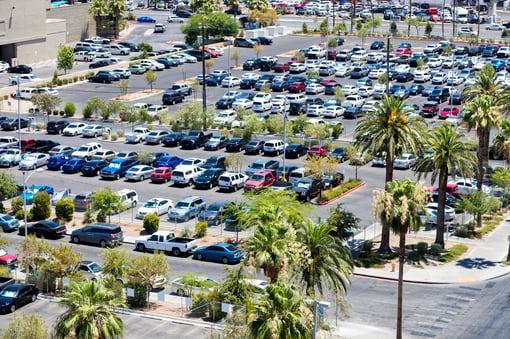Here's the first of our two-part interview with Geospatial Insight's resident GeoFinance expert and development lead for RetailWatch - the only Satellite-based solution for monitoring of European out-of-town retail outlets.
What can you tell us about your business?
Geospatial Insight provides data and insights derived from the analysis of satellite, aerial and drone imagery. We apply machine learning to capture key features and events, which enables us to produce evidence-based intelligence. We service multiple markets, the two most relevant are insurance/insurtech and financial services/fintech. In insurance, we provide catastrophe response information and building and environmental information which services risk-based pricing and brokerage models. In financial services/fintech, we’re increasingly finding those same datasets relevant to mortgage valuation and risk assessment, but like many in the alternative data industry we’ve tended to focus more on buy-side alpha-oriented datasets, including physical commodities and consumer footfall.What has been your journey to current position?
I worked for 20 years at MathWorks. For those with quant, engineering or mathematics backgrounds, that’s the company behind MATLAB. For about half of that time, I was Industry Manager of the Financial Services team. As a geographer among mostly engineers, I could feel out-of-place, but I was also quite good at being able to see the wood or forest while others came to terms with individual trees and so I was able to help the company understand how the many different types of people in finance, economics and insurance were using these engineering toolsets. While there, I was immensely privileged to participate in the evolution of the financial services industry, what I call the Seven Ages of Quant. I’ve also been lucky to have had a holistic bird’s eye view of the industry crossing buy-side and sell-side, niche hedge fund and bulge-bracket bank, navigating front, back and middle offices, into insurance and then into the very different cultures of central banks, NGOs, think tanks and regulators.
Towards the end of that time, economists and insurers aside, serious modelling was increasingly a standardized function of the middle office for tasks like risk-based accounting, while the fast-and-furious types of the front offices and hedge funds were taking up open source. My fun quota was diminishing while fewer doors opened to us. More by luck than judgement, 18 months ago I attended a satellite in financial services event courtesy of a freebie from a training services company I had an affiliation with. At the time, I struggled to reconcile the content presented to the finance applications, that I had encountered at least. However, after sleeping on things, attending a couple of thought-provoking alternative data events soon after (most sentiment-based, but usually incorporating satellite chat on their panel discussions), it all began to make sense. I realised how I could both open my mind and get back to the leading edge of finance, while working with the satellite specialists to help translate these great data sources into something useful for the financial services industry and I somehow found myself a job with one of the speakers from the event I had crashed.
What interested you in this space?
Two things: first, getting back to being at the leading/bleeding edge of the industry – it’s lovely to have hedge funds and front office traders interested in what we’re up to. Second, I’m now working for a company where geography intersects with – and is integral to - finance, rather than among applications where it’s abstracted out.
How have you settled into the business?
It’s exciting, challenging, scary, vibrant and hand-to-mouth in equal measure. It’s been a roller coaster, but good for me. I’ve learnt to have sleepless nights, but also challenge myself and be challenged!
What lessons did you learn in your previous role?
Finance is a unique industry. Most other industries have established processes and model standards. They manage model development cycles well, which is why planes fly safely in the skies and cars (mostly) are increasingly reliable. Finance thinks it does development best, and in some cases it does, e.g. applying agility across development cycles. However, it’s also a technology basket-case, incorporating fad after fad into last decade’s increasingly aging, inefficient and risky legacy stack. On the other hand, the business environment is fast-paced and vibrant, run by people with creativity to see new things and willing to take a risk (perhaps with an inflated bonus in mind) to make good and not-so-good things happen. There are reasons things happen first in finance. At both my last engineering company and my new (according to LinkedIn) “defense and space” company, I’ve conveyed that financial services is a world on its own. You must embrace it on its terms, and not try to impose norms of other industries onto it, and I love it for that.
Where do you see the opportunity for you in the UK and European market?
Alternative data has been led from America and sometimes that means the rest of the world doesn’t always get as much dataset focus as they’d like. That can be useful to those of us building datasets and insights in Europe and the UK.
What are some of the major challenges facing the industry that your company overcomes?
First, a realization that place is important. Geographically contingent information, whether for identifying mis-priced trades, capturing leading edge information on an asset or helping with due diligence, risk assessment and in advanced stress testing is now deemed important. Second, what I call Geofinance and others call “spatial finance”, the blending of geography with financial analytics, modelling and insights, is a real and socially useful thing. It contributes to sustainable finance, in practical terms helping to construct ESG models or incorporate climate scenarios into risk and stress testing models. It’s helping make finance more purposeful than it has been years, more attractive to those considering entering the industry, and we’re part of that trend, particularly in terms of the provision of real data.




